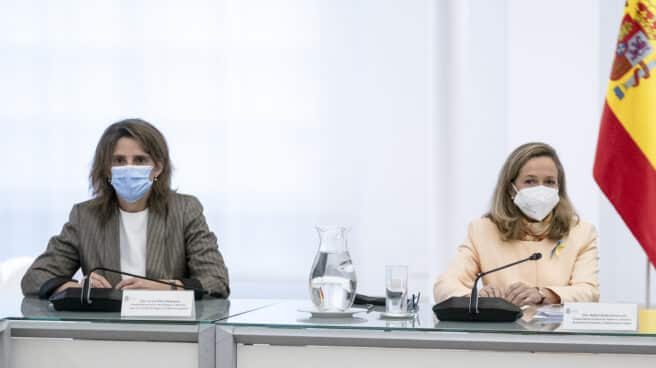

Third Vice President and Minister for Ecological Transition and Population Teresa Ribera (left) and Economy Minister Nadia Calvinho.
Paper holds everything. Schedules and calendars too. Moreover, the provision of millionaire assistance to overcome the crisis may depend on them. Reality, on the other hand, is different. The millionth rain from European funds, which in many cases is received by Spain, is still waiting for its recipient. Making a call Plan for Recovery, Transformation and Resilience (PRTR) it is very unequal in times and ministries. So far, looking at the level of allocated funds, it can be concluded that the Ministries of Nadia Calvinho (Economics and Digital Transformation) and Teresa Ribera (Environmental Transition and Demographic Challenges) are accumulating the biggest delay: around $10,000 million Next Generation. “resources” are still waiting for their fate.
On the other hand, his cabinet colleague, the Minister of Industry, Trade and Tourism, Reyes Maroto, can presently present the best pace of implementation of the Plan. Even better than originally thought. As of May 31, the Ministry of Maroto has already allocated 86.6% of the resources of the “Next Generation” program that correspond to it. This represents a total of 6,400 million euros, almost double the expected 3,500 million (47.2%) in May this year.
The data presented in a report prepared by the consulting company LLYC, which analyzes the degree of implementation of European assistance, concludes that at the current level this will not happen until December next year, when Spain manages to allocate all the received European resources.
It is added that along with the slow process of providing community resources -driven by reforms– There is no information on their effective execution. The report notes that there is no information “on PRTR spending that reached its final recipients”: “This raises doubts about the impact on the real economy of Spain, public understanding and the credibility of the government,” he says. .
Pending bets
Thus, in the case of two ministries that accumulate a large delay in their spending obligations, it is indicated that the Ministry of Economy and Digital Transformation planned to allocate an amount of 6,000 million euros by these dates. However, until the end of May last year, they only had spending commitments of 4,300 million euros. In the case of the Ministry of Environmental Transformations and Demographic Problems, the difference between what was planned and what was done is much larger. The forecast was 10,000 million and the liabilities were about 4,300 million euros.
A bidding process that in many cases results in significant delays. In tenders scheduled for the second half of this year, many of the cases are actually late calls that should have been resolved in the first half of this year. Thus, out of the EUR 11,000,000,000,000,000,000 of assistance from European funds that will be disbursed between now and the end of the year, USD 3,000,000,000,000 are for calls rescheduled from the first half of 2022.
In the coming months, calls for projects such as the so-called “Digital Kit” (1,000 million), an energy storage project (150 million) or actions related to the development of green hydrogen (195 million), or tenders related to the area should be solved by rail and port (nearly 3,000 million).
Expected Reforms
The LLYC report looks at the funds received by Spain so far. The first of them reached 10 billion euros in the middle of last year. The second payment, requested in April last year, was about 12 billion euros. A third aid package of 6 billion euros is expected by the end of this year, although its implementation could be changed in the future by issues such as an agreement on social security contributions for the self-employed.
The first, scheduled for next year, with another 10,000 million euros, could be hampered by the reforms that are supposed to support it and that affect sensitive areas such as pension reform, start-up law or sports law.
Source: El Independiente